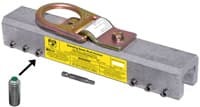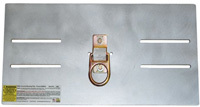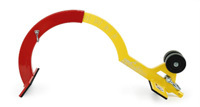Fall Protection Equipment For Morin Standing Seam Roofs
Posted by Howie Scarboro - CEO Fall Protection Distributors, LLC on Oct 7th 2024
See the Roof Anchor Compatibility Chart for Morin Standing Seam Panels.
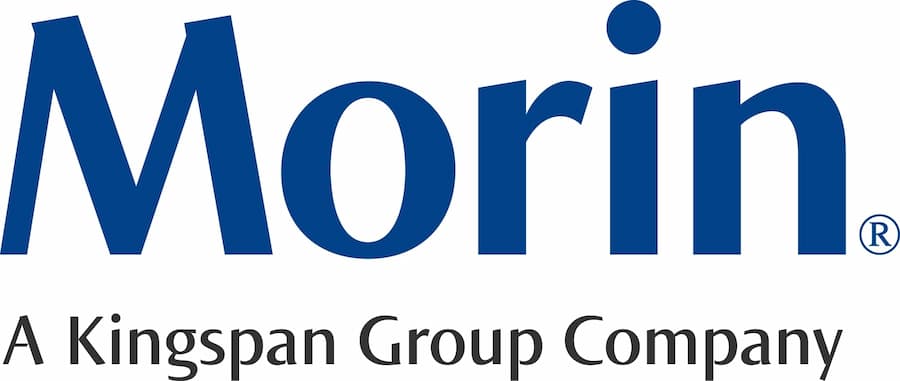
Who Is Morin by Kingspan?
Established in the early 1960s in Bristol, Connecticut, Morin has built a reputation as a leader in the architectural metal panel industry, specializing in wall and roof systems. Initially a steel installation company, Morin evolved into a versatile manufacturer, offering over 100 different architectural profiles designed to meet the needs of diverse construction projects. Morin is known for its ability to deliver customized solutions that allow architects and designers to bring unique visions to life.
In 2008, Morin joined Kingspan Group, a global leader in building envelope solutions. This acquisition allowed Morin to expand its capabilities and align with Kingspan's ambitious sustainability goals, including achieving net-zero status by 2020. Today, Morin operates three production facilities across the U.S. and continues to push boundaries in architectural design through innovation and digital technology, supported by Kingspan's extensive research and development resources.
Why Compatible Fall Protection Is Critical For Morin Standing Seam Roofs
Researching and selecting compatible fall protection for Morin standing seam roofs is critical to ensuring worker safety and maintaining the roof's structural integrity. With their sleek profiles and concealed fasteners, standing seam roofs present challenges when attaching fall protection systems. Traditional methods can damage the roof surface, leading to leaks or weakening the roof's durability.
Choosing the proper fall protection products tailored to each Morin roof profile prevents roof damage while providing reliable safety for workers during installation and maintenance. Ensuring compatibility with Morin's architectural designs meets safety regulations and protects the investment in high-performance, weather-tight roofing systems.
SLR Panels - Watertight Versatility
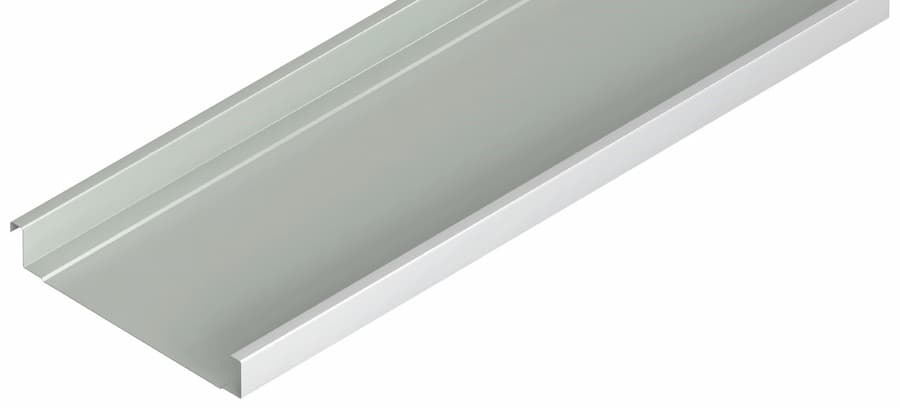

Morin's SLR Series panels come in 12", 16", and 18" widths with a 2" seam height and a minimum roof pitch of ½:12. These standing seam panels are mechanically seamed and offer a versatile solution for architectural designs, with the option to transition from roof to wall. Installers can mechanically seam these panels at 90 or 180 degrees, depending on the roof slope. When seamed at 180 degrees, the panels deliver exceptional watertight performance, even on roofs with slopes as low as ½:12. The SLR panels are also available with on-site roll-forming to eliminate panel end laps, ensuring seamless installation from eave to ridge. Curving is an option for roofs with a 20' radius or more, providing architects greater design flexibility. See the Roof Anchor Compatibility Chart for Morin SLR Standing Seam Panels.
SLR panels are available in a wide range of substrates, including aluminum, galvalume, stainless steel, zinc, and copper, as well as in standard and custom finishes. Their clip relief design allows for thermal expansion and contraction, making them ideal for projects requiring high-performance, durable roofing.
Fall Protection for SLR Panels
SSRA1 Seam Anchors, SSRA2 Adjustable Roof Jacks, and SSRA3 Anchor Plates
For 22—and 24-gauge steel SLR panels, the SSRA1 Seam Anchors, SSRA2 Adjustable Roof Jacks, and SSRA3 Anchor Plates provide a comprehensive fall protection solution. These components work together to offer secure, non-penetrating fall protection, preserving the integrity of the standing seam while ensuring worker safety.
SSRA1 Seam Anchors: These anchors clamp onto the roof's seams without penetrating the surface, providing a strong and stable anchorage point for fall arrest systems. Their non-penetrating design ensures the roof remains watertight, making them an ideal choice for maintaining the performance of the SLR panels.
SSRA2 Adjustable Roof Jacks: These roof jacks attach to the SSRA1 anchors, allowing workers to install walk boards across the standing seam roof. This system provides a stable walking surface for workers, enabling them to move safely across the roof while performing installation or maintenance tasks.
SSRA3 Anchor Plates: The anchor plates mount onto the SSRA1 Seam Anchors and offer a reliable attachment point for temporary horizontal lifeline systems.
This system of SSRA products ensures that workers can install and use temporary lifelines and walkboards without damaging the roof, keeping the SLR panels' watertight properties intact.
For substrates other than 22 and 24-gauge steel, such as aluminum, zinc, copper, or stainless steel, the Ridge Pro Steep Assist is the most compatible fall protection solution for roofs with a pitch between 6/12 and 12/12. This device hooks securely over the roof peak and allows workers to maintain 100% tie-off at all times. It provides safe access to the roof and is ideal for use on steeper pitches where more traditional anchors might not be appropriate or compatible.
Curved Roof Panels
Curved SLR panels present unique challenges regarding fall protection. Since curved roofs require specialized approaches, neither the SSRA system nor the Ridge Pro Steep Assist suits these applications. An on-site inspection from a trained safety professional should precede any installation or maintenance work on curved roof systems.
SWL Panels - Minimalistic Snap-Lock
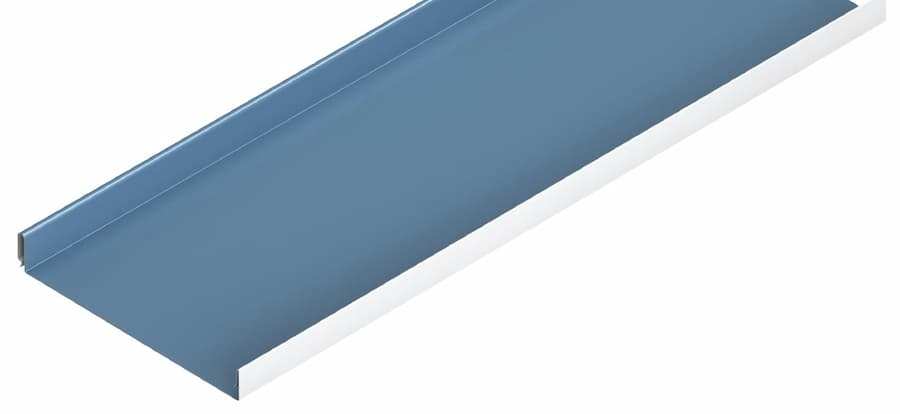

Morin's SWL profile offers a 1-3/4" seam height with 12", 16", and 18" widths. This panel utilizes a minimalistic snap-lock seam design that simplifies installation while ensuring panel strength. Ideal for architectural applications, the SWL panel is commonly installed over a weatherproof barrier, helping to shed rainwater efficiently while delivering a sleek, modern appearance. With a minimum pitch requirement of 2:12, the SWL panels provide flexibility for various architectural projects. They are available in aluminum and galvalume, with other metal substrates available upon request. See the Roof Anchor Compatibility Chart for Morin SWL Standing Seam Panels.
One of the critical features of SWL panels is the availability of on-site roll-forming in continuous lengths, eliminating the need for panel end laps, which enhances the overall performance and appearance of the roof. Additional design options, such as straight tapered panels and an optional batten for a clean, finished look, offer customization for both functional and aesthetic needs.
Fall Protection for SWL Panels
SSRA1 Seam Anchors, SSRA2 Adjustable Roof Jacks, and SSRA3 Anchor Plates
For 22 and 24-gauge steel SWL panels, the SSRA1 Seam Anchors, SSRA2 Adjustable Roof Jacks, and SSRA3 Anchor Plates provide a comprehensive solution for non-penetrating fall protection. These products work together seamlessly to provide a safe environment for workers while maintaining the structural integrity of the roof:
SSRA1 Seam Anchors: These anchors clamp securely onto the seams without needing roof penetration, making them an ideal choice for the snap-lock design of SWL panels. Using a non-penetrating attachment method, the SSRA1 preserves the roof's integrity while providing a solid anchor point for safety systems.
SSRA2 Adjustable Roof Jacks: The roof jacks connect to the SSRA1 anchors, enabling the installation of walk boards along the standing seam. This setup offers workers a stable surface to move across the roof, ensuring safety during installation and maintenance.
SSRA3 Anchor Plates: These anchor plates attach to the SSRA1 Seam Anchors and are a secure point for temporary horizontal lifelines. This system allows multiple workers to safely access the roof, maintaining 100% tie-off without compromising the roof's watertight features.
This combination of SSRA products ensures that workers can safely navigate and work on the roof without risking damage to the SWL panel system while complying with fall protection requirements.
For substrates other than 22 and 24-gauge steel, such as aluminum or galvalume, the Ridge Pro Steep Assist is the best fall protection option for roofs with pitches between 6/12 and 12/12. This device hooks over the roof's peak, allowing workers to maintain continuous tie-off while navigating steeper roof slopes. The Ridge Pro Steep Assist offers a reliable solution for maintaining safety in more challenging applications where traditional anchor systems may not be suitable.
Curved Roof Panels
Workers must take special precautions when installing the SWL panel on a curved roof. The SSRA products and Ridge Pro Steep Assist are incompatible with curved panels. In these cases, a trained safety expert must conduct an on-site inspection to develop a suitable fall protection plan.
MorZip Panels - Architectural Solution for Low Pitches
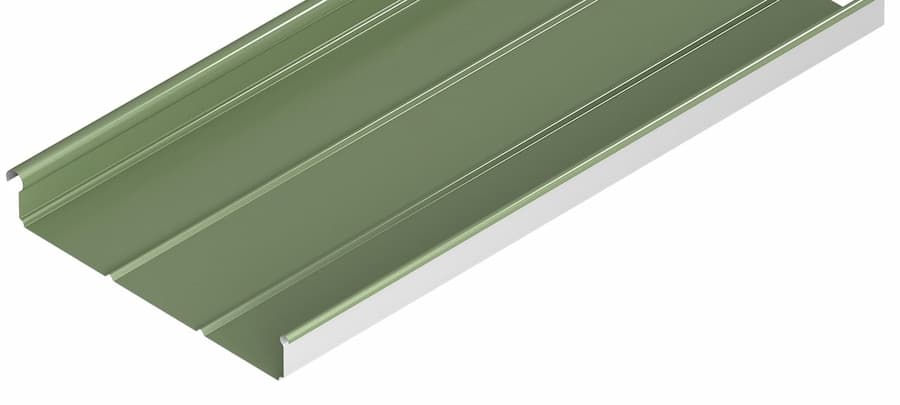

Morin's MorZip® system offers unmatched weather tightness with 2-1/2" seam heights and widths of 12", 16", and 18", making it ideal for architectural applications. With the ability to handle roof pitches as low as ½:12, this system is perfect for projects requiring curved or tapered panels. The MorZip panels can be installed on roofs, walls, or both, creating a seamless design across various architectural elements. On-site roll-forming ensures panels can be manufactured in continuous lengths, eliminating the need for panel end laps and enhancing the system's weather resistance. See the Roof Anchor Compatibility Chart for Morin MorZip Standing Seam Panels.
Curving capabilities make MorZip exceptionally versatile, with options for convex lay-down, convex mechanical, and concave mechanical curves. Whether straight, tapered, or curved, the hidden clip fastening system ensures a sleek, uninterrupted surface, free from through-fasteners. MorZip panels are available in a wide range of materials, including aluminum, galvalume, stainless steel, zinc, and copper, providing architects with flexibility in design and finish options.
Fall Protection for MorZip Panels
SSRA1 Seam Anchors, SSRA2 Adjustable Roof Jacks, and SSRA3 Anchor Plates
For MorZip panels made from 22 and 24-gauge steel, the SSRA1 Seam Anchors, SSRA2 Adjustable Roof Jacks, and SSRA3 Anchor Plates offer reliable, non-invasive fall protection:
SSRA1 Seam Anchors: These seam anchors securely clamp onto the standing seams of MorZip panels without penetrating the surface, preserving the roof's watertight properties. The SSRA1 anchors provide strong anchor points for fall protection systems, ensuring worker safety during installation and maintenance.
SSRA2 Adjustable Roof Jacks: Attached to the SSRA1 Seam Anchors, these adjustable roof jacks allow workers to install walk boards across the standing seam panels. This ability creates a stable, non-penetrating platform for workers to navigate the roof safely, reducing the risk of falls.
SSRA3 Anchor Plates: These anchor plates are mounted on the SSRA1 Seam Anchors to provide secure attachment points for temporary horizontal lifelines. This system allows multiple workers to remain safely tethered to the roof, providing complete protection while maintaining the structural and aesthetic integrity of the MorZip panels.
These components work in tandem to create a comprehensive fall protection system that safeguards workers without compromising the performance or appearance of the MorZip panel system.
For MorZip panels made from substrates other than 22 and 24-gauge steel, such as aluminum, copper, or zinc, the Ridge Pro Steep Assist is the most suitable fall protection solution for roofs with a pitch between 6/12 and 12/12. This device hooks securely over the roof's peak, allowing workers to maintain continuous tie-off while working on steeper pitches. The Ridge Pro Steep Assist provides an effective solution for maintaining safety on roofs with materials that may not be compatible with SSRA systems.
Curved Roof Panels
Curved MorZip panels present unique challenges regarding fall protection. We do not recommend using SSRA products or the Ridge Pro Steep Assist due to the complexity of curved roof systems. Instead, an on-site inspection by a trained safety professional is necessary to determine the most appropriate fall protection strategy.
Symmetry Panels - T-Seam Designed For Easy Replacement
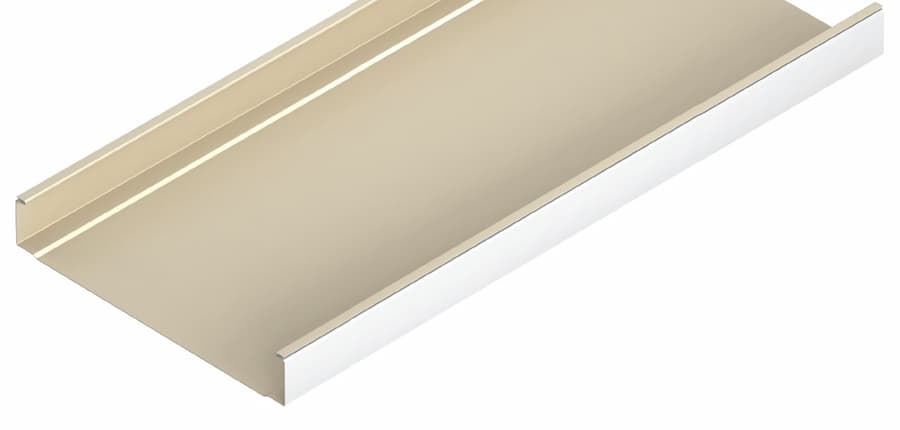

The SymmeTry® system from Morin offers a robust, batten-seamed roof solution designed to withstand extreme environmental conditions. Available in 12", 16", and 18" widths, with seam heights of 1.5", 2", 2.5", and 3", Symmetry panels are ideal for projects where durability, thermal movement, and wind resistance are crucial. The system's "T"-shaped joints are identical, allowing for easy panel installation and replacement while accommodating unlimited thermal expansion and contraction. This feature provides enhanced resistance to wind uplift, making it suitable for harsh climates. See the Roof Anchor Compatibility Chart for Morin Symmetry T-Seam Standing Seam Panels.
With a minimum roof pitch requirement of 1:12, the Symmetry system offers on-site roll-forming options to eliminate panel end laps. Additional design options include panel stiffening ribs or striations for added strength. The panels are available in aluminum and galvalume, with custom finish options to meet specific architectural requirements.
Fall Protection for Symmetry Panels
SSRA1 Seam Anchors, SSRA2 Adjustable Roof Jacks, and SSRA3 Anchor Plates
For Symmetry panels made from 22 and 24-gauge steel, the SSRA1 Seam Anchors, SSRA2 Adjustable Roof Jacks, and SSRA3 Anchor Plates offer a comprehensive fall protection solution:
SSRA1 Seam Anchors: These seam anchors securely clamp onto the standing seams without penetrating the surface, preserving the roof's weatherproof integrity. They provide strong and stable anchor points for fall protection systems, ensuring workers remain safe while working on Symmetry roofs.
SSRA2 Adjustable Roof Jacks: Connected to the SSRA1 Seam Anchors, these roof jacks allow for the safe installation of walk boards. This non-invasive system provides a stable surface for workers to move across the roof during installation or maintenance, reducing the risk of falls.
SSRA3 Anchor Plates: These anchor plates mount on top of the SSRA1 Seam Anchors, creating secure points for temporary horizontal lifelines.
This fall protection system allows workers to access Symmetry panels safely without compromising the roof's watertightness or performance.
For substrates other than 22 and 24-gauge steel, such as aluminum or galvalume, the Ridge Pro Steep Assist is the best option for roofs with pitches between 6/12 and 12/12. This system hooks securely over the roof peak, allowing workers to maintain continuous tie-off and ensuring safety on steeper slopes. The Ridge Pro Steep Assist provides a practical solution for fall protection on materials that may not be compatible with SSRA products.
Curved Roof Panels
Curved Symmetry panels require a more specialized approach to fall protection. Due to the unique challenges of curved roof systems, neither SSRA products nor the Ridge Pro Steep Assist are suitable. Instead, a trained safety expert should conduct an on-site inspection to determine the most appropriate fall protection strategy, ensuring worker safety and the integrity of the curved roof.
Standing Seam Metal Roof Anchor Panel Compatibility Chart For Morin by Kingspan
Non-Curved |
SLR Panels |
SWL Panels |
MorZip Panels |
Symmetry T-Seam |
|---|---|---|---|---|
| YES | YES | YES | YES | |
| YES | YES | YES | YES | |
| YES | YES | YES | YES | |
| YES | YES | YES | YES | |
| YES | YES | YES | YES |
Contact Us For More Information
For further details on roofing solutions and fall protection systems, contact us at 863-703-4522 or www.StandingSeamRoofAnchor.com. Let's work together to make your roofing projects safe, beautiful, and built to last. For more safety tips, check out OSHA's 48-page fall protection manual. Once you have determined the most suitable anchors for your roof system, download our free Anchor Inspection Form.
Safety Guidelines for Standing Seam Roofs
Equip workers with top-tier safety equipment
Providing all workers with high-quality fall protection gear, such as full-body harnesses and shock-absorbing lanyards, is essential. This gear reduces the risk of injury by lessening the impact forces in the event of a fall.
Ensure safe access at all times
Proper ladder and scaffolding setup is crucial for maintaining stability. Workers should receive ladder safety training and follow OSHA's 4-to-1 rule to minimize the risk of falls when accessing elevated areas.
Establish protective barriers in work zones
Using guardrails, warning lines, or other barriers on low-slope roofs helps clearly define safe zones. These measures reduce the likelihood of falls by marking off areas where workers should exercise extra caution.
Emphasize a culture of safety
Creating a safety-first environment involves routine equipment checks and consistent training. Regular safety drills and inspections ensure workers stay vigilant and aware of potential risks, fostering a safer workplace overall.
Choose the suitable anchor systems for the job
When working on standing seam roofs, it's essential to use roof anchors designed for these specific surfaces. Follow installation guidelines and avoid systems that require placement over panel clips, which can be challenging to locate on existing roofs.
Take extra steps for curved metal roof safety
Standard seam-mounted anchors may not be suitable for projects involving curved metal roofs. To address the unique challenges of curved surfaces, safety experts should provide input in developing a tailored fall protection plan.
Train workers on using trauma straps
Trauma straps are essential for preventing suspension trauma after a fall. Attach these straps to all workers' harnesses and train them thoroughly, especially for long-duration suspension situations.
Install permanent roof anchors for ongoing safety
Permanent roof anchor systems are essential for roofs that will require frequent maintenance. These anchors provide a reliable tie-off point for future work, ensuring ongoing safety for workers who return to the site.
Develop a comprehensive OSHA-compliant safety plan
Before starting any job, prepare a thorough, OSHA-compliant safety plan. This plan must include detailed rescue procedures so all workers know the necessary steps in an emergency.
Wear proper footwear for roofing
Ensuring that workers wear non-slip footwear specifically designed for metal roofs prevents slips. Proper footwear provides better grip and stability, especially on slick or wet surfaces, reducing the chance of accidents.
Disclaimer
The views, recommendations, and information presented in this blog are solely those of the author and do not necessarily reflect the opinions or positions of the featured panel manufacturer, its brands, subsidiaries, or parent companies. Customers are strongly encouraged to reach out directly to the roof panel manufacturer for inquiries regarding fall protection compatibility with their products and to address any potential warranty issues that may arise following the installation of our products.



